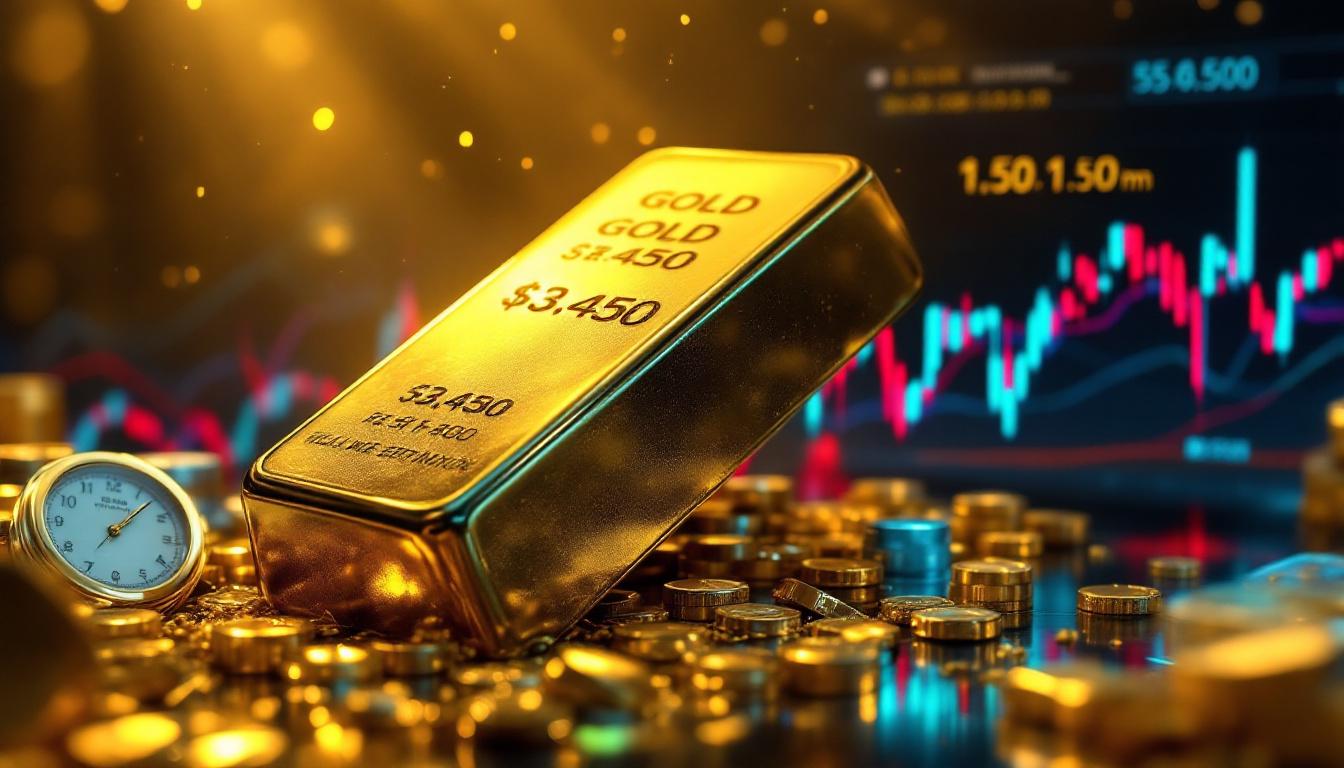What Makes Gold a Hedge Against Inflation and Global Uncertainty?
Gold has traditionally been viewed as a hedge against inflation, but its utility extends far beyond that simple function. As Ed Yardeni, president of Yardeni Research, explains: "Gold is a hedge against a lot of things including geopolitical chaos, which is kind of what we have now." With tensions between China and Taiwan escalating and global trade relationships in flux, gold's exceptional rise continues to strengthen its appeal as a safe haven asset.
Since Nixon closed the gold window in August 1971, gold has experienced only two major bull markets. These cycles tend to be prolonged, with the current gold bull market beginning when Russia invaded Ukraine in 2022. Recent price action shows gold breaking through the $3,000 mark, with technical analysis suggesting potential targets of $4,000 by end of 2024 and $5,000 by end of 2025.
The metal's performance during times of geopolitical uncertainty has reinforced its status as a store of value that transcends national borders and political disputes. Its historical role during similar periods of chaos provides investors with a framework for understanding current price movements.
The Historical Role of Gold During Economic Uncertainty
Gold's inverse correlation to the U.S. dollar and Treasury yields underscores its function as a safe haven during tumultuous times. The breakout above $3,000 signals a significant shift in institutional demand diversification, as investors seek protection from inflation and geopolitical chaos.
Russia's $300 billion reserve freeze in 2022 serves as a stark reminder of sovereign risk, prompting emerging markets to increase their gold holdings by an impressive 34%. Similarly, the 1970s stagflation era saw gold prices rise by an astonishing 2,300% amid oil crises and monetary instability.
These historical examples demonstrate gold's enduring value during periods of economic uncertainty and geopolitical tensions. The current environment of inflation and geopolitical chaos bears striking similarities to past periods when gold outperformed most other asset classes.
Why Central Banks Are Accumulating Gold
Countries concerned about U.S. asset freezes (like what happened to Russia) are actively diversifying their reserves away from dollar-denominated assets. China's gold reserves have increased by 16% year-over-year, while other nations like Russia, Venezuela, and Iran have been "loading up on gold" as protection against unpredictable monetary policies.
Central bank gold buying represents a fundamental shift in global reserve strategies, moving away from excessive reliance on the U.S. dollar. This trend accelerated following the 2022 Russian invasion of Ukraine, which triggered unprecedented financial sanctions and demonstrated the vulnerability of dollar-based reserves.
The accumulation of gold by central banks serves as a buffer against both economic and political risks, offering a degree of monetary sovereignty that fiat currencies cannot provide in an increasingly fractured global landscape.
How Are Trump's Tariffs Creating Market Volatility?
The recent market volatility can be traced to what analysts call "Trump Tariff Turmoil 2.0." This policy approach has created significant uncertainty in global markets and trade relationships, leading to pronounced movements across various asset classes.
Bond yields spiked dramatically from 4% to 4.5% within days of the tariff announcements, while the NASDAQ briefly entered bear territory. These sharp reactions highlight the market's sensitivity to trade policy shifts and their potential impact on economic growth and inflation.
Economists project that these tariffs could add 1-2% to U.S. inflation by Q4 2025, according to Congressional Budget Office models. Simultaneously, credit spreads for high-yield bonds widened by 120 basis points post-announcement, indicating growing concern about corporate profitability under the new trade regime.
Understanding the Scale and Impact of New Tariffs
The tariff structure introduced includes a 10% blanket tariff on all imports to the United States, a 25% tariff on automobiles, and 100-200% tariffs specifically targeting Chinese goods. Additionally, reciprocal tariffs were announced for countries that impose tariffs on U.S. goods, though these were later postponed, triggering an impressive 7% rebound in the S&P 500 on April 9, 2025.
The auto industry responded to these announcements by significantly increasing inventory levels, resulting in a 22% surge in Q1 2025. This stockpiling effect has been observed across multiple sectors as businesses attempt to mitigate the impact of impending tariffs.
These protectionist measures represent a marked shift in U.S. trade policy, creating ripple effects throughout global supply chains and financial markets. The uncertainty surrounding their implementation and potential retaliation from trading partners continues to drive market volatility.
Market Reactions to Tariff Announcements
Credit quality spreads began widening shortly after the tariff announcements, indicating growing stress in credit markets. This trend reflects investors' concerns about corporate profitability and debt servicing capabilities in a higher-cost environment.
The S&P 500 approached bear market levels before rebounding on news of potential delays in tariff implementation. This volatility underscores the market's sensitivity to trade policy developments and the significant impact they can have on investor sentiment.
Gold prices surged as investors sought safe havens amid the uncertainty, reinforcing the metal's status as a hedge against both inflation and geopolitical chaos. This flight to safety reflects growing concerns about economic stability and the potential for prolonged trade disputes.
Is Stagflation a Real Threat to the Economy?
The combination of tariffs, inflation concerns, and slowing growth has revived discussions about stagflation—a challenging economic environment characterized by high inflation alongside weak economic growth. This scenario presents unique challenges for policymakers and investors alike.
Inflation forecasts have been revised upward from the 2-3% range observed in 2023 to a potential 3-4% range in 2025, while GDP growth projections have been downgraded to approximately 1.5%. This combination of higher prices and slower growth creates the classic conditions for stagflation.
As Yardeni warns, "We could have a few quarters where inflation is above three, close to 4% or in that range, and where real GDP growth is very lackluster," though he stops short of predicting 1970s-level stagflation.
Current Inflation Outlook
Energy prices contribute approximately 30% to CPI fluctuations, with recent oil price drops of 15% in early 2025 potentially offsetting some tariff-driven inflation. However, this relief may be temporary if global energy markets tighten due to geopolitical risks.
Wage growth remains relatively flat at 2.1%, suggesting limited pass-through from labor costs to inflation. However, retailers and importers have been stockpiling goods ahead of tariff implementation, with inventories reaching $1.2 trillion in March 2025—a level that could temporarily suppress price increases but eventually lead to higher costs for consumers.
The Turkish and Argentine economies in 2024 demonstrated inflation rates approaching 8% despite low growth, providing contemporary examples of stagflationary conditions. While the U.S. situation differs in important ways, these cases offer cautionary tales about the potential economic impact of persistent inflation combined with weak growth.
Growth Projections Under Tariff Pressure
U.S. consumer spending growth slowed to 1.2% in Q1 2025, reflecting increasing caution among households facing higher prices and economic uncertainty. This pullback represents a significant drag on overall economic growth, given that consumer spending accounts for approximately 70% of U.S. GDP.
Margin squeezes appear likely as companies face higher input costs but struggle to pass them all to consumers. This pressure on profitability could lead to reduced investment and hiring, further constraining economic growth potential.
Reduced unit sales growth is expected as consumers pull back on spending, particularly for discretionary items. This decline in demand presents additional challenges for businesses already coping with higher costs and narrowing profit margins.
How Is the Federal Reserve Responding to These Challenges?
The Federal Reserve finds itself in a difficult position, caught between conflicting policy objectives as it navigates inflation concerns and economic growth uncertainties. The central bank's 2024-2025 "hold" strategy has maintained interest rates at 5.25-5.5% despite the introduction of tariffs, reflecting its focus on inflation control.
The Fed's dilemma centers on whether to prioritize inflation control or economic growth support. Lowering rates could exacerbate inflation but support growth, while maintaining higher rates could control inflation but risk recession. This balancing act has become increasingly complex with the addition of tariff-induced price pressures.
The central bank's credibility remains at stake after previous inflation forecasting challenges, making any policy pivot particularly delicate. Jerome Powell has indicated that the Fed is "boxed in" by tariff impacts, limiting its room to maneuver effectively.
The Fed's Policy Dilemma
The "stealth mandate" to prevent financial crises remains in place if market stress becomes severe, with reverse repo facilities capable of absorbing up to $2 trillion in liquidity if needed. This backstop represents an important tool for maintaining financial stability during periods of market stress.
The 2023 bond vigilante-driven yield surge to 5% forced the Fed to inject liquidity, highlighting the limits of monetary tightening in an environment of significant fiscal expansion. This episode serves as a recent reminder of the complex interplay between monetary policy, fiscal policy, and market dynamics.
Treasury has shifted approximately 60% of 2025 debt issuance to short-term bills to manage yields, a strategy that has implications for the Fed's policy effectiveness and future flexibility. This approach may temporarily alleviate pressure on long-term rates but could create challenges for monetary policy implementation going forward.
The "Fed Put" on Hold
The traditional "Fed put" (lowering rates during market stress) appears to be on standby as Powell has resisted pressure to accommodate tariffs with rate cuts. This stance reflects the Fed's continued prioritization of inflation control over market stability.
Japan's 2024 foreign exchange interventions to stabilize the yen provide a contemporary example of a major central bank responding to market pressures. While the Fed faces different challenges, the Japanese experience illustrates the difficult trade-offs that monetary authorities must navigate in today's complex global economy.
The Fed remains concerned about its dual mandate of controlling inflation and maintaining employment, with current policy decisions reflecting a judgment that inflation risks currently outweigh growth concerns. This prioritization could shift if economic data deteriorates significantly or financial market stress intensifies.
What Does This Mean for the U.S. Dollar's Global Position?
Recent market turmoil has sparked discussions about the dollar's future as the world's reserve currency, with some predicting a decline in its dominance. However, structural factors continue to support the dollar's central role in the global financial system.
The U.S. dollar's reserve share has declined from 59% in 2020 to 54% in 2025, reflecting gradual de-dollarization efforts by various countries. This trend represents a slow but meaningful shift in global reserve composition, though it falls short of the dramatic collapse some have predicted.
With U.S. debt refinancing needs reaching $7 trillion in 2025 and China holding approximately $760 billion in Treasury securities, the dynamics of global financial flows remain critically important for dollar stability and U.S. economic policy.
Factors Supporting Dollar Strength
The U.S. remains the world's largest consumer market, accounting for 25% of global GDP and 40% of global consumer spending. This economic heft provides fundamental support for the dollar's international role, as global businesses must engage with American markets and consumers.
America's entrepreneurial economy continues to drive innovation and attract investment from around the world. As Yardeni argues, this "entrepreneurial dynamism and deep capital markets" underpins the dollar's ongoing appeal despite mounting challenges.
U.S. capital markets provide exceptional access to venture funding and investment opportunities, reinforcing the country's financial centrality. Additionally, abundant natural resources including farmland, minerals, oil, and gas contribute to America's economic resilience and the dollar's foundational strength.
Challenges to Dollar Dominance
De-dollarization efforts have gained momentum, with examples like India's rupee-ruble trade pact demonstrating practical mechanisms for bypassing the dollar in international commerce. These arrangements, while still limited in scope, represent meaningful steps toward a more multipolar currency system.
The Economist's contrasting covers—"Roaring Dollar" in 2024 versus "Scream" in 2025—illustrate the shifting narrative around the U.S. currency. These changing perceptions can influence policy decisions and market behavior, potentially accelerating trends already underway.
Growing concerns about U.S. fiscal sustainability with government debt exceeding $35 trillion undermine confidence in the dollar's long-term stability. This fiscal burden represents a significant vulnerability that could weaken the dollar's position if left unaddressed.
How Should Investors Position Their Portfolios?
Given the current environment of inflation and geopolitical chaos, investors face challenging decisions about asset allocation and risk management. Gold allocations in institutional portfolios have risen from 2% in 2023 to 8% in 2025, reflecting growing concerns about inflation and geopolitical risk.
Equity sentiment indices hit 20-year lows in April 2025, a contrarian bullish signal that suggests potential opportunities despite the challenging macroeconomic backdrop. This extreme pessimism often occurs near market bottoms, though timing such inflection points remains notoriously difficult.
The 10-year Treasury's 4.5% yield appears to reflect stagflation hedging rather than growth optimism, providing a potential income stream but limited protection against inflation. This yield level suggests continued uncertainty about economic prospects and inflation trajectory.
The Case for Maintaining Equity Exposure
Market timing remains extremely difficult, with April 8th potentially marking the market bottom following the initial tariff announcement shock. The subsequent recovery demonstrates the risks of exiting positions during periods of peak pessimism.
Extreme bearish sentiment often serves as a contrarian indicator, suggesting potential value for investors willing to take a longer-term perspective. Historical data shows that investing during periods of widespread pessimism has typically generated above-average returns over subsequent 12-24 month periods.
The administration likely wants to avoid prolonged market turmoil ahead of midterm elections, potentially limiting further disruptive policy announcements. This political calculation could provide a temporary floor for market sentiment and asset prices.
The Role of Gold in Modern Portfolios
Gold serves as "a very good hedge against chaos," according to Yardeni, who advises "holding gold as chaos insurance" while maintaining equity exposure. This balanced approach recognizes gold's protective qualities without abandoning growth assets.
April 2025's "triple witching" options expiry amplified market volatility, highlighting the importance of diversification during periods of market stress. Such events can trigger temporary dislocations that test investor discipline and portfolio construction.
Even non-traditional gold investors are considering allocations, reflecting broader recognition of the metal's diversification benefits in the current environment of inflation and geopolitical chaos. This widening investor base provides additional support for gold market trends 2025.
Bond Market Considerations
"Bond vigilantes" have become increasingly powerful due to the size of government debt, as demonstrated by Bill Aman's profitable 2023 bond short that capitalized on the 4-5% yield swings. This episode highlights the market's ability to discipline fiscal excess through higher borrowing costs.
Treasury strategies may shift toward more short-term bill issuance versus longer-term bonds, potentially steepening the yield curve and creating opportunities for fixed-income investors. This approach reflects the government's attempt to manage borrowing costs in a challenging market environment.
Bond yields could move higher if auctions show weak demand, particularly from foreign investors concerned about dollar depreciation or geopolitical risk. The Fed may need to intervene if bond market volatility threatens financial stability, potentially creating policy conflicts with its inflation-fighting mandate.
Conclusion: Navigating Inflation and Geopolitical Chaos
In an environment characterized by inflation and geopolitical chaos, investors must balance traditional asset allocation principles with new realities. Gold and silver strategies have been reinforced by recent events, while equity markets continue to offer long-term growth potential despite near-term volatility.
The Federal Reserve's policy constraints highlight the complex interplay between inflation, growth, and financial stability in today's interconnected global economy. Meanwhile, the dollar's reserve currency status faces gradual rather than dramatic challenges, supported by America's economic fundamentals but undermined by fiscal concerns.
For investors, the current landscape demands flexibility, diversification, and a clear-eyed assessment of both risks and opportunities. By understanding the historical context of gold's performance during similar periods and recognizing the potential for market sentiment to swing rapidly, portfolios can be positioned to weather current uncertainties while capturing future growth. The Gold ETFs guide and recent historic gold deal highlight additional options for those looking to gain exposure to the precious metals sector.
Looking for Early Alerts on the Next Major ASX Discovery?
Discovery Alert's proprietary Discovery IQ model provides real-time notifications when significant mineral discoveries are announced on the ASX, giving you a crucial market advantage before the broader market reacts. Explore how historic discoveries have generated exceptional returns by visiting our dedicated discoveries page and position yourself to capitalise on the next major find.




